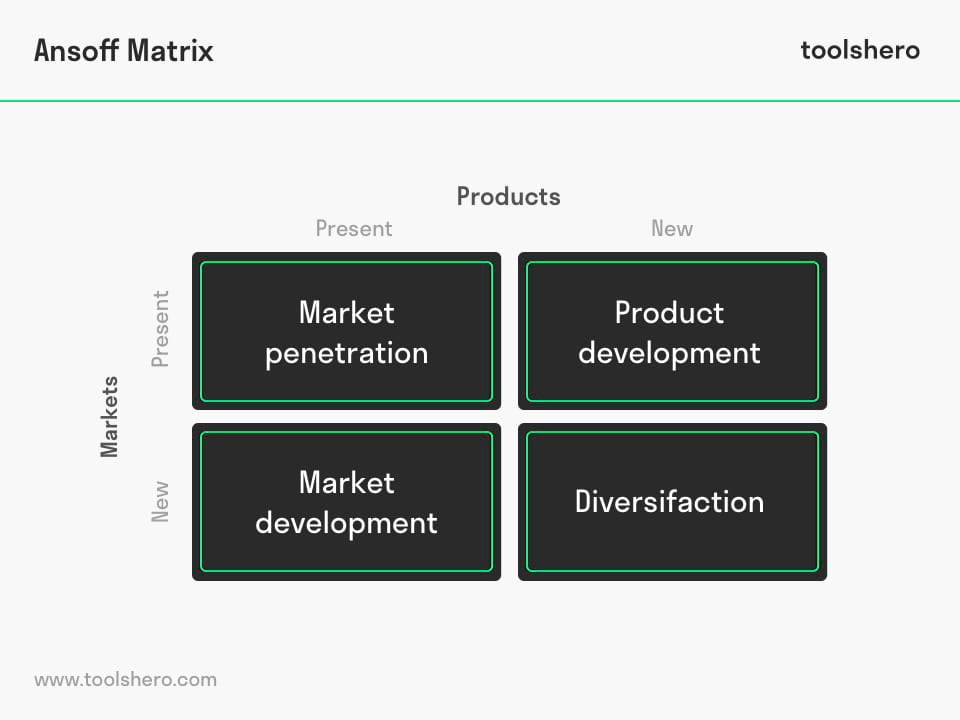Ansoff Matrix explained plus example

Ansoff Matrix: this article explains the Ansoff Matrix by Igor Ansoff in a practical way. It covers an Ansoff Matrix example, what the Ansoff growth matrix is, along with an explanation of the four strategies, and what its limitation are. After reading you will understand the basics of this marketing strategy tool. Enjoy reading!
Introduction
“Stagnation means decline.” This is a significant starting principle for both profit and non-profit organizations.
When an organization wants to grow, it is important to take the right steps. Based on the factors product/ service and markets there are four different growth strategies that need to be developed and which have been set out in a matrix by Igor Ansoff, the Ansoff matrix.
What is the Ansoff Matrix?
This Matrix was developed by strategy professor Igor Ansoff in the 1960s.
The idea behind the Ansoff Matrix is simple; a company or organization gains a clear insight into the possible growth strategies based on the combination of existing and new products and existing and new markets. These could also be services instead of products.
The term market is aimed at concrete markets as well as various target groups. In addition, Ansoff’s Growth Matrix should always be considered from the perspective of the organization.
This strategic planning tool, Ansoff’s Growth matrix, is connected to the general strategic direction of an organisation. Additionally, four alternative growth strategies are presented in the table, being:
- Market growth: market penetration by pushing existing products in market segments
- Market development: development of new markets for existing products
- Product development: developing products for existing markets
- Diversification: developing new products for new markets
An Ansoff Matrix example
The Ansoff Matrix, also referred to as the product market matrix or growth matrix, can be divided into four strategies. Here, Igor Ansoff indicates that growth occurs in steps. For instance, he believes diversification can only be chosen after the stages of market penetration, product development and market development have been completed. Below is a brief and practical clarification.

Figure 1 – The Four Strategies of the Ansoff Matrix (Ansoff, 1965)
Market Penetration
This is a product/ market combination of a current product, offered in the current market; opening a new branch and/or focusing on competitors’ customers.
With this strategy, the organisation uses its own products in the existing market. In other words, a company aims to increase its market share with a penetrating market strategy. This market penetration can be conducted in several ways:
- Lower price to attract existing or new customers
- Greater efforts in the field of promotion and distribution
- Acquiring a competitor in the same market/ sector
An example of this are companies in telecommunication. These are all active within the same market and often use a penetration strategy by lowering their prices and increasing their distribution and promotion efforts.
Another example of a company that successfully deploys this strategy is Coca-Cola. This company, just like Heineken, is known for spending a lot of money on marketing to penetrate and conquer new markets.
Additionally, they try to maximise the use of distribution channels by closing attractive deals with large distributors such as supermarkets, restaurants and football stadiums.
Product Development
This is a product/ market combination of a new product, offered in a current market; renewing and improving the product range and attracting more customers this way.
In the product development strategy, a company develops a new product to meet the needs of consumers of an existing market. The shift typically includes extensive market research and development and expansion of the current product range. The product strategy is often used when companies are well informed of what is going on in the market, and are able to offer innovative solutions to meet the needs of the existing market. The product development strategy can be implemented in several ways:
- Investing in Research & Development to develop new products that respond to the existing market
- Acquiring a competitor’s product and joining forces to develop a new product that better meets consumers’ requirements
- Entering into strategic partnerships with other companies to gain access to the distribution channels and other resources of each partner
An example of product development strategy is a car company that manufactures electric cars to meet the consumers’ changing needs. The current consumers in the car market are typically becoming more eco-friendly.
Another example of a company that excels in applying product development is Apple. Every so often, Apple markets a brand-new smartphone, the iPhone, that is always an improvement of the last model. Other examples can be found in the pharmaceutical industry, where new and innovative medication is frequently developed.
Market development
The third quadrant of the Ansoff Matrix represents market development. This is a product/ market combination of a current product, offered in a new market; the own product range offered in a different way, such as online, abroad or through franchise at another company.
The market development strategy is applied when a company enters a new market with their existing product portfolio. Expansion to new markets means that companies expand to new regions, customer segments, etc. The market development strategy is most effective when:
- A company has its own technology and can utilise this in new markets
- Consumers in the new market are profitable
- Consumer behaviour doesn’t deviate much from existing markets
The market development strategy can be applied in several ways:
- Catering to a different customer segment
- Entering a new domestic market
- Entering a new foreign market
Examples of companies that have successfully managed to do this are Nike and Adidas. The two companies offer the same products to the market in China and Europe, for instance.
Diversification
This is a product/ market combination of a new product, offered in a new market; tapping into a new market with a new product range (parallelisation is an example of this).
The diversification strategy is applied when a company enters a new market with a new product. Such a strategy is by far the most risky of the four. This is due to the fact that this strategy demands both market and product development. On the other hand, diversification could also reduce future risk.
There are two types of diversification strategies a company may apply:
- Related diversification: when potential synergies can be realised between existing activities and the new product or the new market
- Unrelated diversification: there are no potential synergies to be realised between the existing activities and the new product or the new market
A manufacturer of handmade leather shoes that starts to produce phones is an example of an unrelated diversification strategy. When the same producer of leather shoes starts a line of leather wallets or other leather accessories, this is an example of related diversification.
Risks
As the growth strategy shifts from current products and markets to new products and markets, this increases the risk for the organisation. A new market must be explored and it takes time before new demographics are familiar with the products of a new provider.
Moreover, strategy guru Igor Ansoff emphasises that diversification is therefore actually separate from the other three strategies.
Ansoff Matrix limitations
The Ansoff matrix has several limitations that are important to consider before actually applying the tool in practice. Read the following points.
Isolation through the Ansoff Matrix
When the Ansoff matrix is used as an isolated tool, the results could be misleading. This is due to the fact that it doesn’t take competitors’ activities into account and the competitors’ ability to counter the shift to other industrial sectors.
Additionally, the model doesn’t take into account the risks and challenges involved in changes in an organisation’s daily activities.
A company that hopes to enter new markets or create new products, or both, must consider whether they possess the necessary skills, flexible structures and consenting stakeholders.
Consistency
Several critics indicate that the logic of the Ansoff matrix is dubious at best. These problems concern interpretations about novelty.
When one assumes that a product is truly new for a company, the product will often bring the company to a new, previously unknown market as well. In that case, one of the Ansoff quadrants, diversification, becomes redundant. On the other hand, when a new product doesn’t necessarily bring the company to a new market, the combination of new products in new markets doesn’t always equal diversification, as it concerns a completely unknown company.
Conclusion on the Ansoff Matrix
The Ansoff matrix is an effective framework for assessing a company’s options, with the goal to grow. The market penetration strategy is the least risky of the four and occurs most frequently in everyday situations.
Diversification is the most risky because a company introduces a completely unknown product to a completely new market. However, when a company is successful in entering unrelated markets, the advantage is that this creates a diverse portfolio, reducing the overall risk.
In such a situation, it’s helpful to work with other frameworks, such as the GE matrix or the BCG Growth-Share-matrix.
It’s Your Turn
What do you think? Is the Ansoff Matrix applicable in today’s modern economy and marketing? Do you recognize the practical explanation or do you have more suggestions? What are your success factors for the good matrix set up?
Share your experience and knowledge in the comments box below.
More information
- Ansoff, H. I. (1965). Corporate strategy: business policy for growth and expansion. McGraw-Hill.
- Ansoff, H. I. (1980). Strategic issue management. Strategic Management Journal, 1(2), 131-148.
- Green, P. E. (1977). A new approach to market segmentation. Business Horizons, 20(1), 61-73.
- Webster Jr, F. E. (1988). The rediscovery of the marketing concept. Business horizons, 31(3), 29-39.
How to cite this article:
Mulder, P. (2013). Ansoff Matrix. Retrieved [insert date] from Toolshero: https://www.toolshero.com/strategy/ansoff-matrix/
Original publication date: 07/14/2013 | Last update: 11/08/2023
Add a link to this page on your website:
<a href=”https://www.toolshero.com/strategy/ansoff-matrix/”>Toolshero: Ansoff Matrix</a>












